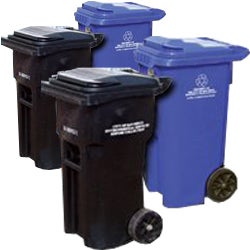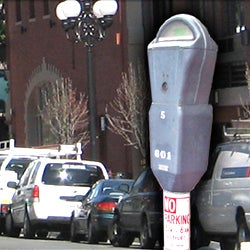Pilot Projects and Studies
The City of San Diego's Stormwater Department conducts a number of pilot projects in an attempt to find the most efficient and cost-effective method in preventing pollution in local beaches, bays and the ocean. Projects include structural improvements to the City’s storm drain system, porous pavement projects, outreach programs designed to educate and change behaviors and attitudes in residents and businesses.
Bioassessment Tools for Restoration and Protection
The City of San Diego's Stormwater Department is dedicated to using new, innovative technology to efficiently and effectively provide clean, safe water to all San Diego communities. As part of a Supplemental Environmental Project in partnership with the San Diego Regional Water Quality Control Board, the City has developed tools to better analyze the biology of our streams to help us, and others in Southern California, prioritize them for restoration, protection and other projects.
The two parts, a Causal Assessment Screening tool and a Restoration and Protection Prioritization tool, are illustrated in the fact sheets linked below. The tools are available to the public for use, but please note that they require a background and understanding of bioassessment processes to fully interpret the results.
This project was undertaken as part of a settlement of San Diego Water Board enforcement action.
Information about the tools:
 CASQA Presentation
CASQA Presentation Bioassesment Tool Fact Sheet
Bioassesment Tool Fact Sheet Restoration and Protection Tool Fact Sheet
Restoration and Protection Tool Fact Sheet Bioassessment Tool Final Report
Bioassessment Tool Final Report
Access to the tools:
- https://tetratech-wtr-wne.shinyapps.io/CASTool_SMC
- https://tetratech-wtr-wne.shinyapps.io/RPPTool_SMC
43rd Street and Logan Avenue Project
The City of San Diego is installing a Low Impact Development (LID) pilot project as part of roadway improvements surrounding the intersection of 43rd Street and Logan Avenue. The LID effort will use Best Management Practices to help capture and treat storm water before it can enter nearby Chollas Creek.
43rd Street and Logan Avenue Project
Chollas Creek Family Stream Team Initiative
The Groundwork San Diego Chollas Creek Chollas Creek Family Stream Team Initiative was a grant-funded effort to provide outreach and assistance by engaging the local community to participate in trash cleanup, landscape assistance, and trash collection activities to address illegally-dumped materials and pollutants in Chollas Creek. This program component is considered a non-structural best management practice designed to reduce illegal dumping in the Chollas Creek watershed by providing periodic collection services where local residents can dispose of large, unwanted household items for free.
Chollas Creek Family Stream Team Initiative
Kellogg Park Green Lot Infiltration Project
The California State Water Resources Control Board created Areas of Special Biological Significance (ASBS) to protect our oceans and prevent pollution within some of the most pristine and biologically diverse sections of California’s coast. La Jolla is home to two ASBS, which encompass a large portion of the La Jolla Shores marine environment. To address the issue of run-off into the ASBS, the City has developed a priority development project at Kellogg Park in La Jolla Shores. The Kellogg Park Green Lot project is designed as a treatment control utilizing best management practices in the parking lot to treat storm water and urban runoff. The project includes elements that will capture surface runoff from the parking lot and public right-of-way. The elements will filter and infiltrate the water to minimize pollutants.
Kellogg Park Green Lot Infiltration Project
Rain Barrel and Downspout Disconnect Pilot Program
The Rain Barrel/Downspout Disconnect Pilot Program was developed to study the effectiveness of rain barrel systems at reducing polluted runoff and harvesting water during dry periods. The pilot program was designed as a cost effective way to reduce polluted runoff from entering San Diego beaches and bays, conserve water, and supplement existing water harvesting efforts.
Rain Barrel and Downspout Disconnect
Street Sweeping Pilot Studies
The City of San Diego continues to explore new ways to help prevent storm water pollution. As part of this ongoing effort, the Stormwater Division conducted a pilot study of street sweeping options for neighborhoods adjacent to important waterways. The studies involved assessment of what kind of street sweeping equipment and sweeping frequency helped reduce the amount of pollutants on our roadways.
Catch Basin Inlet Cleaning Pilot Study
The Catch Basin Inlet Cleaning plan focuses on characterizing accumulation rates and pollutants in four land use settings that broadly represent large areas of San Diego. These areas are specifically downtown San Diego, a single-family residential area in San Ysidro, a residential area near San Diego Mesa College and Tecolote Creek, and a mixed commercial and office/retail area off of Scripps Poway Parkway and Interstate 15. Four clean-outs were performed during the winter season of 2011 to 2012.
Stormwater Runoff Impacts of Copper and Zinc Building Materials, Literature Review
This report reviewed zinc and copper as pollutants and how source abatement efforts may effectively serve as a best management practice. The study concludes that the lack of studies for the application and management of zinc- and copper-based building materials limits the scientific foundation and understanding about the economic, social, political and environmental implications of restricting the use of the materials.
![]() Stormwater Runoff Impacts of Copper and Zinc Building Materials
Stormwater Runoff Impacts of Copper and Zinc Building Materials
Storm Drain Insert Pilot Study
This pilot study evaluated the performance and operations and maintenance requirements of storm drain insert best management practices at eight different locations throughout the City. Five different products were selected for evaluation during both wet and dry weather conditions. The level of effort required to maintain these best management practices was also evaluated. This study assists the City in consideration of future implementation of various best management practices and in storm water planning efforts.
![]() Storm Drain Insert Pilot Study
Storm Drain Insert Pilot Study
Preliminary Evaluation of an Illegal Dumping Abatement Non Structural BMP
This report assesses the effectiveness of a non-structural best management practice program designed to reduce illegal dumping in the Chollas Creek watershed. This report documents activities and analysis methods that were used to assess the effectiveness of parts of the Chollas Creek Family Street Team Initiative program that address illegal dumping and trash pollutant issues in portions of the Chollas Creek Watershed.
![]() Evaluation of an Illegal Dumping_Abatement_Non-Structural BMP
Evaluation of an Illegal Dumping_Abatement_Non-Structural BMP
Polycyclic Aromatic Hydrocarbon Transport Study: Project Summary Report
Polycyclic aromatic hydrocarbons (PAHs) are an ongoing potential source of pollution in the environment; they are released from petroleum products or the incomplete combustion of organic matter, especially related to the use of oil, gas, coal, and wood for transportation and energy production in urban environments. In elevated concentrations, PAHs can be harmful to human health and toxic to aquatic biota. In 2012, the City of San Diego’s Stormwater Department began a several phase study that sought to determine the sources of PAHs and there relative concentration in the San Diego Bay Watershed. The San Diego Regional Water Quality Control Board also contributed funds to complete the last phase of the study in 2017.
![]() Polycyclic Aromatic Hydrocarbon Transport Study Report
Polycyclic Aromatic Hydrocarbon Transport Study Report
![]() Appendix A. Quality Assurance Project Plan
Appendix A. Quality Assurance Project Plan
![]() Appendix B. Data Quality Objectives and Quality Assurance / Quality Control Review
Appendix B. Data Quality Objectives and Quality Assurance / Quality Control Review
![]() Appendix D. Summary Statistics
Appendix D. Summary Statistics
![]() Appendix E. Diagnostics Ratios
Appendix E. Diagnostics Ratios
Sediment Load Reduction Quantification through Outfall Repair and Relocation for the Los Peñasquitos WMA
The sediment load reduction quantification through outfall repair and relocation for the Los Peñasquitos Watershed Management Area was completed to assess the current loading to the Los Peñasquitos Lagoon caused by the erosive scour associated with outfall discharge, as well as possible load reductions associated with various best management practices.























